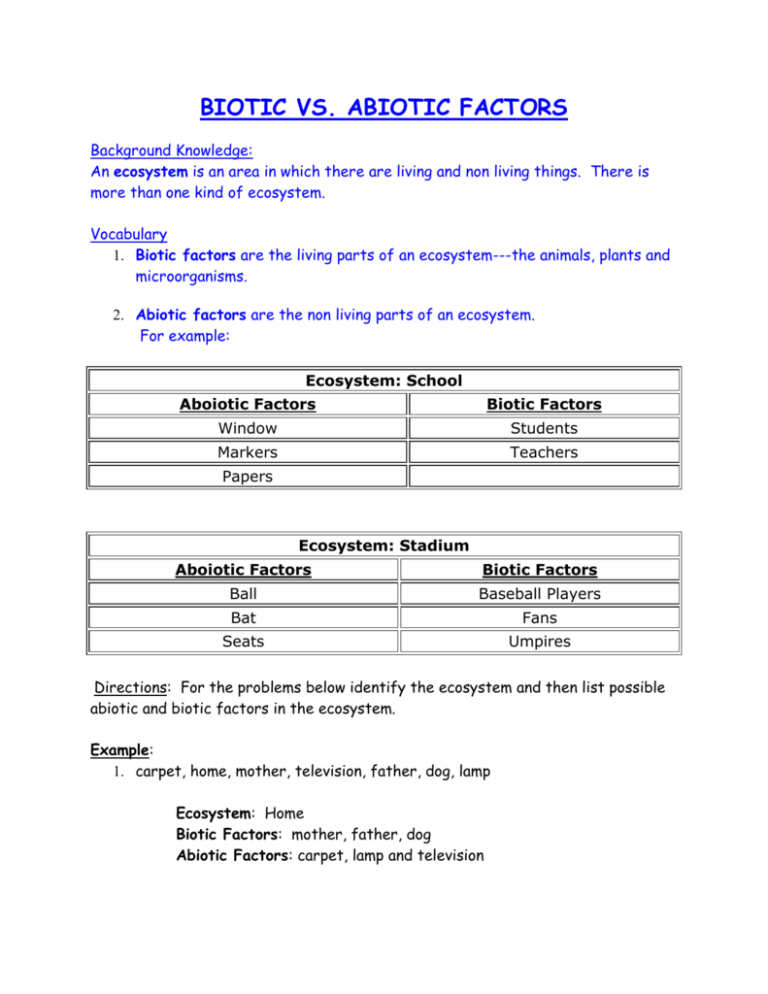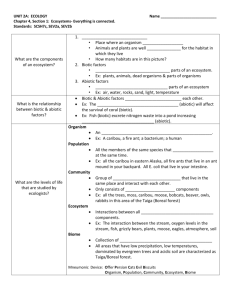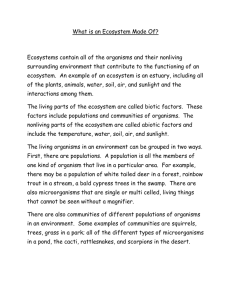Biotic vs. Abiotic Factors Worksheet | Ecosystems
advertisement

BIOTIC VS. ABIOTIC FACTORS Background Knowledge: An ecosystem is an area in which there are living and non living things. There is more than one kind of ecosystem. Vocabulary 1. Biotic factors are the living parts of an ecosystem---the animals, plants and microorganisms. 2. Abiotic factors are the non living parts of an ecosystem. For example: Ecosystem: School Aboiotic Factors Biotic Factors Window Students Markers Teachers Papers Ecosystem: Stadium Aboiotic Factors Biotic Factors Ball Baseball Players Bat Fans Seats Umpires Directions: For the problems below identify the ecosystem and then list possible abiotic and biotic factors in the ecosystem. Example: 1. carpet, home, mother, television, father, dog, lamp Ecosystem: Home Biotic Factors: mother, father, dog Abiotic Factors: carpet, lamp and television 2. lake, fish, boat, plants, sunlight Ecosystem: Biotic Factors: Abiotic Factors: 3. classroom, students, eraser Ecosystem: Biotic Factors: Abiotic Factors: 4. Mr. Tucker, Mrs. Zingery, lint, Mr. Barrett, school bus, paper Ecosystem: Biotic Factors: Abiotic Factors: 5. Please provide your own example of the vocabulary terms reviewed. Ecosystem: Biotic Factors: Abiotic Factors: Name:______________________ Hour:___________________ Abiotic vs Biotic Factors What is the definition of an abiotic factor? _____________________________________________________________________ What is the definition of a biotic factor? ____________________________________________________________________________ Enter the items from the following list into a Venn diagram. In the center place what contains both biotic and abiotic factors. Whale Mushroom Water Desert Paper Glass Temperature Coral Sand Clouds Snail Steak Athletes Foot Salad Mold Grass Hair Ocean Tree Rocks Dirt Gold Plastic Grapes Oxygen Tundra Comprehending… All biotic and abiotic factors are interrelated. In nature you will find that if one factor is changed or removed, it impacts the availability of other resources within the system. Knowing this, give an example of what might happen given the following situations. In the open space place either an (A) for abiotic or (B) for biotic to identify the bolded object. 1. All of the rocks(___) are removed from a desert ecosystem, what would happen to the population of rock dwelling lizards (___) and in turn the animals which eat them. _________________________________________________________ _________________________________________________________ _________________________________________________________ 2. A ten mile area of trees (___) is removed from the tropical rainforest. How will this affect the amount of water (___) and the amount of oxygen (___) in the area? __________________________________________________________ __________________________________________________________ __________________________________________________________ INSTRUCTIONS: 1. 2. Choose an ecosystem to draw. In your drawing include the following: 10 different biotic factors 5 different abiotic factors Identify all 15 factors and label whether they are biotic or abiotic factors. Your picture should make sense. Ex.) There shouldn’t be a polar bear in a sand desert! Color your picture for extra credit. Be creative! Further Analysis: Which ecosystem did you choose?___________________ Choose one abiotic factor and one biotic factor from your ecosystem. Imagine that they were suddenly removed. How would your ecosystem change? ___________________________________________________________________ ___________________________________________________________________ ___________________________________________________________________ ___________________________________________________________________ ___________________________________________________________________ ___________________________________________________________________ ___________________________________________________________________







